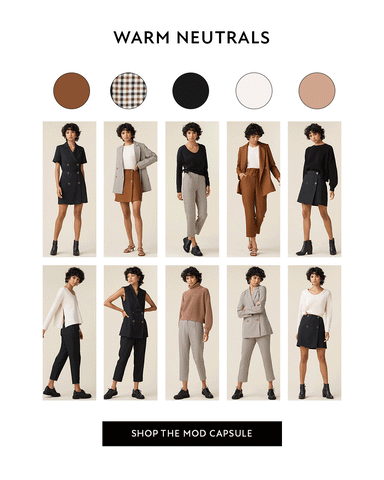Create a Wardrobe Color Palette
This is part of our series on Building a Capsule Wardrobe. In this post, we'll be talking about creating a color palette for your wardrobe.
One of the most helpful things you can do when building a capsule wardrobe (or any wardrobe) is to create a color palette. This allows you to mix and match different items easily, and get the most bang for your wardrobe buck. With a color palette that's well thought out, the pieces in your closet can create tons of outfits, which makes getting way dressed easier. So let's get started.

OBSERVE
The first step is to observe the colors that you already gravitate towards. You can do this by looking at your closet and the "Wardrobe Style Guide" Pinterest board that we created in the last post. Observe if there are any colors that you have a lot of in your closet, and write those down. Then go to the Pinterest board and see if there are any additional colors to add. Your closet speaks more to what you've worn in the past, and your Pinterest board helps give insight into colors you might want more of. By stepping back and seeing all of the clothes / images at once, it helps you to get a feel for what colors and patterns you're drawn to. The Pinterest board is also helpful because it shows the colors together in an outfit, so you can see what looks good together. Think about what colors from your list would go with most things and what colors would be troublesome.
BASE COLORS + ACCENT COLORS
You will want to start with a few base colors and then add a few accent colors. The base colors will be the basics that will make up the core pieces of your wardrobe, the things you wear the most. The accent colors will be for adding pops of color and interest. It's best to focus on just 6-9 total colors at first, because it allows your closet to be really versatile. Later on, you can thoughtfully add more color, but we recommend starting small.
It's helpful to build your wardrobe around cool tones (such as blue, grey, and black) or warm tones (such as camel, ivory, and burgundy). Or you can create a minimal color palette by mixing all of the basics (such as black, white, grey, navy, and ivory). If you love color, you can also try to identify a certain type of color, so that they all go together (like jewel tones or bright colors). You can get creative, just make sure that you would want to wear each color with the other colors.
Sometimes there's a color or print you really like, that doesn't quite fit in with the overall color palette (like you have mostly reds, and you want to add bright green, but don't want it to look like Christmas). You could leave this color out of your main color palette, but still buy stand-alone items in this color like dresses (since they generally don't need to mix and match as much).
PRINTS + TEXTURES
Also think about the different prints and textures that you would want in your wardrobe. Of course, solids are the easiest thing to mix and match, but mixing prints and textures can make your wardrobe more interesting. If you can choose prints that mix and match, it makes your wardrobe much easier to wear. For example, maybe you like floral prints, geometric prints, stripes, and plaids. You realize that floral prints and stripes can be worn together, if they're in the right color palette. You also notice that plaid and stripes can mix and match if they're in black and white, but that geometric patterns just don't go with anything. In that case, you could focus on buying florals, stripes, and plaids in your color palette (in addition to solids).
SEASONALITY
Lastly, it can be helpful to do a color palette for each season, or two color palettes per year (Spring/Summer and Fall/Winter). For example, in the winter, you may wear less white and more deep/dark colors. It's best if most of the colors in your wardrobe are the same year round, and you just add or subtract a few based on the season. That way you can use most tops, pants and accessories in your closet all year, and won't have to buy two separate wardrobes.
Creating a cohesive color palette for your wardrobe will help you get the most out of each item in your closet. With time, getting dressed will be a breeze because you'll have exponential outfit combinations!
Below are a few examples of color palettes to give you some inspiration!
This is part of our series on Building a Capsule Wardrobe. Here is the full list of posts in this series:
4 - Align your closet to your lifestyle
5 - Design your ideal capsule wardrobe
9 - Shop thoughtfully
PS - We'd love for you to keep reading, and download our free worksheet below to follow along. It’s a great asset to print out and keep handy as you're building your wardrobe!






If you'd like to see some examples of color palettes in action, check out VETTA's capsule wardrobes here!










